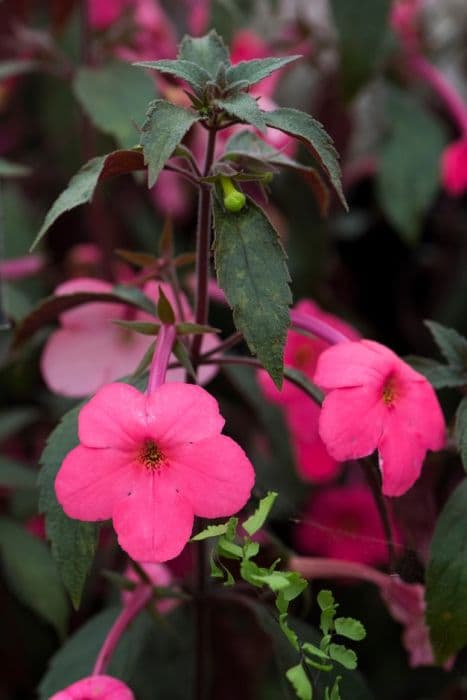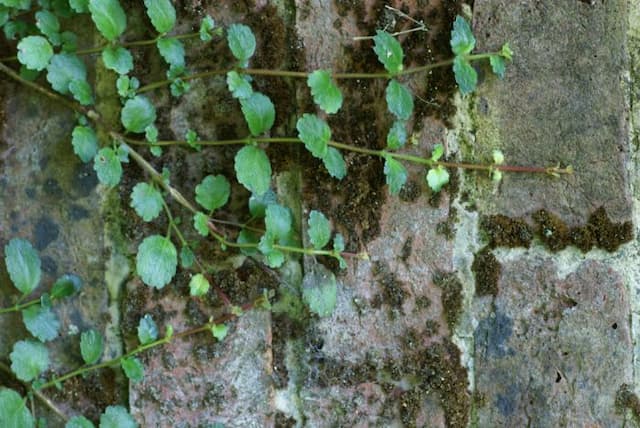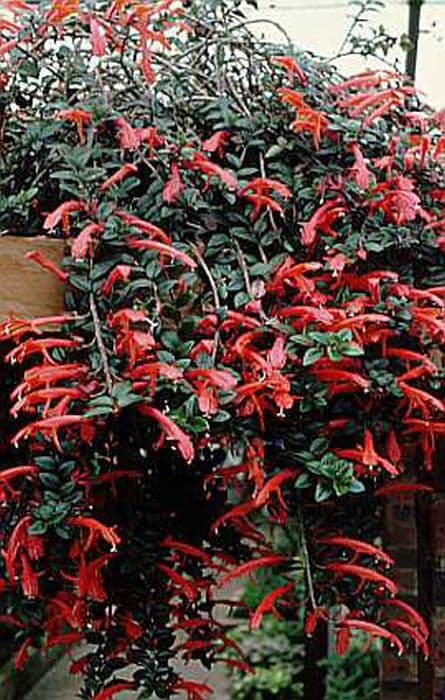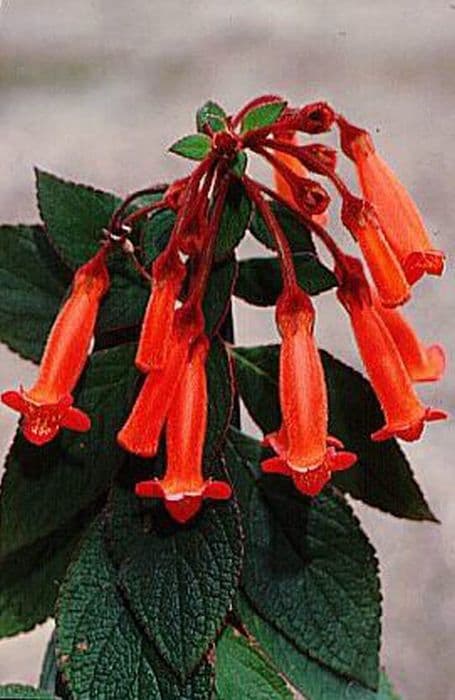Princess Vine Sarmienta scandens

ABOUT
The plant known as Sarmienta scandens is characterized by its wiry, twining stems which enable it to climb surfaces and other plants for support. Its foliage is lush, with leaves that are often deep green in color, though this may vary. The shape of the leaves tends to be oval with a pointy tip, creating a neat, symmetrical appearance. These leaves are usually glossy and may have fine veins running through them that are slightly less apparent than the main leaf surface. Blooming from this plant are flowers that are quite distinctive, typically trumpet-shaped and may come in a variety of colors which can include shades of pink, red, or orange. These blooms often appear in clusters and can add a significant aesthetic appeal to the plant. Sarmienta scandens has a general tendency to form dense mats of foliage as it spreads, creating a carpet-like effect which can be quite pleasing to the eye. Its overall look is one that is vigorous and displays a sense of vitality, often making it an attractive choice for gardeners looking to add lively greenery to their spaces.
About this plant
 Names
NamesFamily
Gesneriaceae
Synonyms
Princess Vine, Strangler Vine
Common names
Sarmienta repens, Sarmientodes scandens.
 Toxicity
ToxicityTo humans
Sarmienta scandens, commonly known as the Princess Vine, does not have a well-documented profile in terms of human toxicity. There is insufficient information available to conclusively state the symptoms and consequences of ingestion for humans. However, as with any plant, it is advisable to avoid ingesting parts of it unless it is known to be safe for consumption. If someone has consumed Princess Vine and poisoning is suspected, medical attention should be sought.
To pets
There is no specific information available regarding the toxicity of Sarmienta scandens, or Princess Vine, to pets such as dogs and cats. Without concrete data, it is not possible to accurately describe the symptoms of poisoning or the consequences of pets ingesting this plant. As a precautionary measure, it is usually best to prevent pets from accessing plants whose toxicity profile is unknown. If you suspect your pet has ingested part of a Princess Vine, it is recommended to consult a veterinarian immediately.
 Characteristics
CharacteristicsLife cycle
Perennials
Foliage type
Evergreen
Color of leaves
Green
Flower color
Pink
Height
1-3 feet (0.3-0.9 meters)
Spread
1-2 feet (0.3-0.6 meters)
Plant type
Climber
Hardiness zones
9
Native area
South America
Benefits
 General Benefits
General Benefits- Ornamental Value: Sarmienta scandens, also known as Princess Vine, is often used for ornamental purposes due to its attractive foliage and climbing habit which adds aesthetic appeal to gardens and indoor spaces.
- Habitat Enrichment: Princess Vine can provide a natural habitat for various species of insects and birds when planted outdoors, promoting biodiversity.
- Soil Erosion Control: Its climbing and spreading nature allows it to cover ground and help stabilize soil, reducing erosion in areas where it is planted.
- Shade Creation: The dense foliage of the Princess Vine can offer shade to both wildlife and humans when grown over arbors or trellises.
- Privacy Screen: When grown along fences or trellises, it can serve as a living privacy screen, concealing areas from view and reducing noise pollution.
 Medical Properties
Medical PropertiesThis plant is not used for medical purposes.
 Air-purifying Qualities
Air-purifying QualitiesThis plant is not specifically known for air purifying qualities.
 Other Uses
Other Uses- Ornamental uses: Sarmienta scandens, commonly known as Llareta, is often cultivated for its dense, mat-forming growth habit, providing aesthetic ground cover in gardens.
- Hanging basket plant: Due to its trailing vines, Llareta can be an attractive plant for hanging baskets, adding greenery to balconies and indoor spaces.
- Green roofing: The thick, cushion-like nature of Llareta makes it suitable for green roofing projects, where it contributes to insulation and building temperature regulation.
- Living walls: Llareta can be used to create living walls or vertical gardens, where its compact growth helps to cover surfaces with foliage.
- Craft material: The stems and foliage of Llareta can be dried and used in the creation of natural, eco-friendly crafts and decoration items.
- Erosion control: The ability of Llareta to form dense mats makes it an effective plant in stabilizing soils and preventing erosion on slopes and banks.
- Ground cover in miniature gardens: Due to its small scale and dense growth, Llareta is used in miniature gardening and fairy gardens as a miniature shrub or lawn alternative.
- Photography: The unique appearance and texture of Llareta make it an interesting subject for nature photography and macro photography enthusiasts.
- Cultural ceremonies: In some indigenous cultures, plants like Llareta are incorporated into traditional ceremonies and rituals for their symbolic meanings.
- Education: Llareta can be used in educational settings, such as botanical gardens, to teach about alpine plants and adaptation to harsh environments.
Interesting Facts
 Feng Shui
Feng ShuiThe Princess Vine is not used in Feng Shui practice.
 Zodiac Sign Compitability
Zodiac Sign CompitabilityThe Princess Vine is not used in astrology practice.
 Plant Symbolism
Plant Symbolism- Resilience: Sarmienta scandens, commonly known as Princess Vine, is adapted to grow in challenging environments, symbolizing the ability to endure and flourish despite adversity.
- Growth and Vitality: With its vigorous climbing habit, Princess Vine is often associated with continuous growth and the vitality necessary to reach new heights.
- Connection: As a climbing plant, Princess Vine symbolizes the interconnectedness of life, reminding us of our need to stay rooted while reaching out for support and kinship.
- Protection: It can offer a natural shield, making it symbolic of safeguarding and creating a safe haven for oneself or others.
 Water
WaterPrincess Flower should be watered regularly to keep the soil evenly moist but not waterlogged. Ideally, it should be watered once a week, providing enough water to saturate the soil to the root level. Depending on the size of the pot and the environmental conditions, this could range from one to two gallons of water per week. During the active growing season in spring and summer, the plant may need more frequent watering, while in fall and winter, it may require less. Always check the top inch of the soil for dryness before watering to avoid overwatering.
 Light
LightPrincess Flower thrives best in bright, indirect light. It can tolerate some partial shade, but too little light may lead to leggy growth and fewer blooms. The ideal spot would be near a window that receives lots of light but is shielded from the harsh direct rays of the midday sun. An east or west-facing window covered with sheer curtains would be suitable for providing the preferred light conditions for this plant.
 Temperature
TemperaturePrincess Flower prefers a warm and stable environment with temperatures ranging between 65°F and 75°F for optimal growth. They can survive in temperatures as low as 50°F but should not be exposed to temperatures below that as they can be damaged by frost. Protect the plant from sudden temperature drops and drafts which can stress the plant and lead to leaf drop.
 Pruning
PruningPruning Princess Flower is important for maintaining its shape and encouraging bushier growth. Prune lightly throughout the growing season to remove any dead or yellowing leaves and trim back leggy stems. The best time for a more thorough pruning is in late winter or early spring before new growth begins. Pruning can be done every year or as needed to control the plant’s size.
 Cleaning
CleaningAs needed
 Soil
SoilFuchsia procumbens, commonly known as creeping fuchsia, thrives in a well-draining soil mix rich in organic matter, such as a mix of peat, perlite, and pine bark. The ideal soil pH for creeping fuchsia should be slightly acidic to neutral, ranging from 5.5 to 7.0.
 Repotting
RepottingCreeping fuchsia should be repotted every 2-3 years or when it has outgrown its current container to ensure continued growth and to refresh the soil.
 Humidity & Misting
Humidity & MistingCreeping fuchsia prefers high humidity levels, ideally between 60-80%, but can tolerate lower humidity with increased attention to watering and soil moisture.
 Suitable locations
Suitable locationsIndoor
Place in bright, indirect sunlight with moist, well-draining soil.
Outdoor
Sheltered spot with indirect light, protect from frost and excessive heat.
Hardiness zone
9-11 USDA
 Life cycle
Life cycleSarmienta scandens, commonly known as Princess Vine, typically begins its life cycle as a seed, requiring warm, moist conditions to germinate. Once the seed germinates, a small seedling emerges, which will develop into a juvenile plant with characteristic heart-shaped leaves and climbing or trailing stems as it matures. The Princess Vine enters its flowering stage, producing small, pinkish flowers which, upon successful pollination, develop into tiny fruit containing seeds. The plant continues to grow and spread, either vegetatively by rooting at stem nodes or by dropping seeds to propagate new plants. Throughout its life, the Princess Vine will experience periods of active growth and dormancy, with growth being more vigorous during warmer seasons. Eventually, the plant may reach a stage where growth slows and it senesces, completing its life cycle.
 Propogation
PropogationPropogation time
Spring-Early Summer
The most popular method for propagating the Sarmienta scandens, also known as the Princess Flower or Magic Flower, is through stem cuttings. The best time to undertake this is in the spring or early summer when the plant is in its active growth phase. To propagate, select a healthy stem and cut a 4 to 6-inch (approximately 10 to 15 cm) length just below a leaf node. Remove the leaves from the lower half of the cutting to prevent rotting when placed in soil. Dip the cut end into rooting hormone powder to encourage root growth and then insert it into a pot filled with a well-draining potting mix. Keep the soil moist but not waterlogged, and place the pot in a warm location with indirect sunlight. Roots should begin to form in a few weeks, after which the new plant can be transplanted into a larger pot or into the garden.









